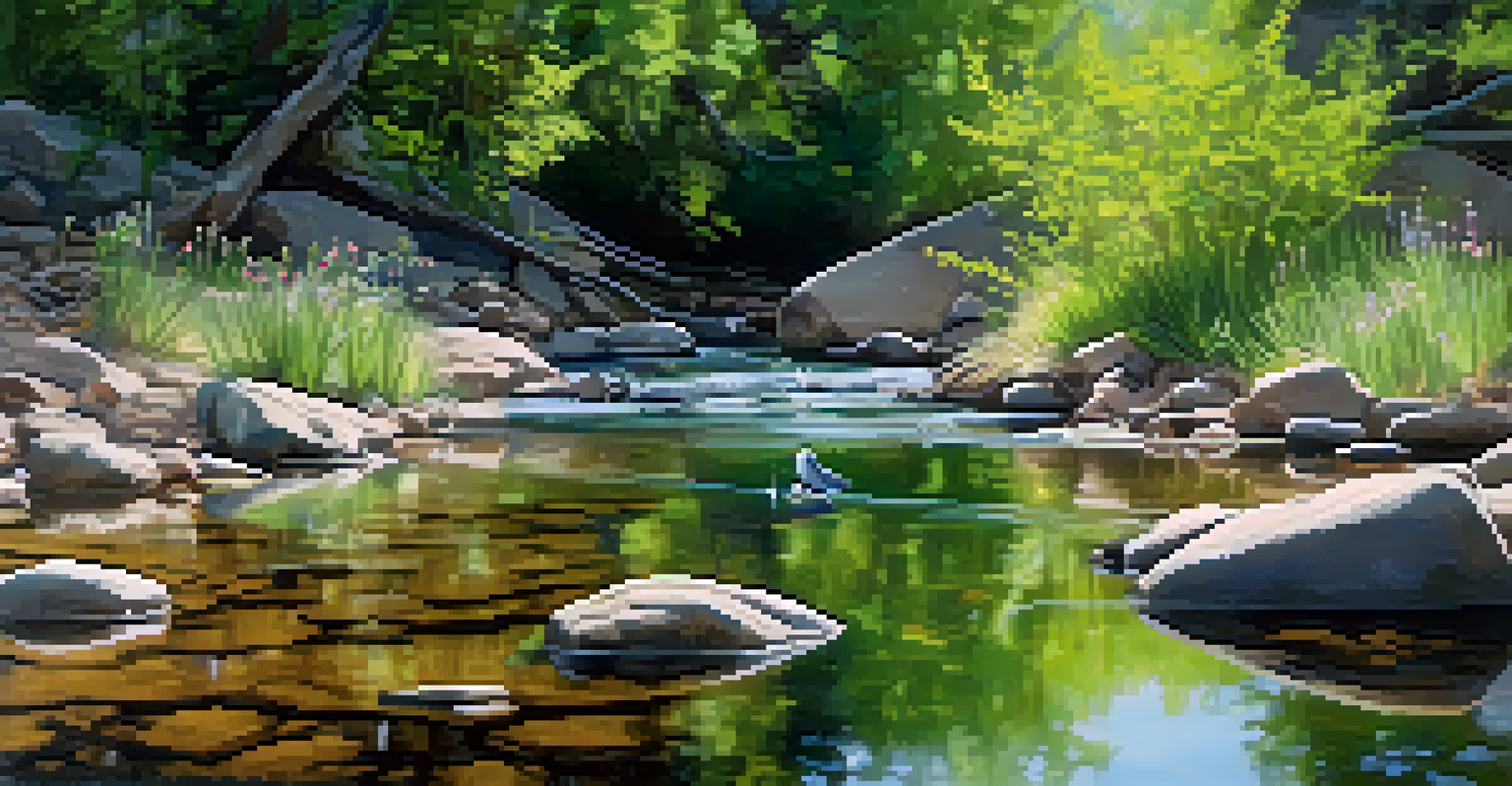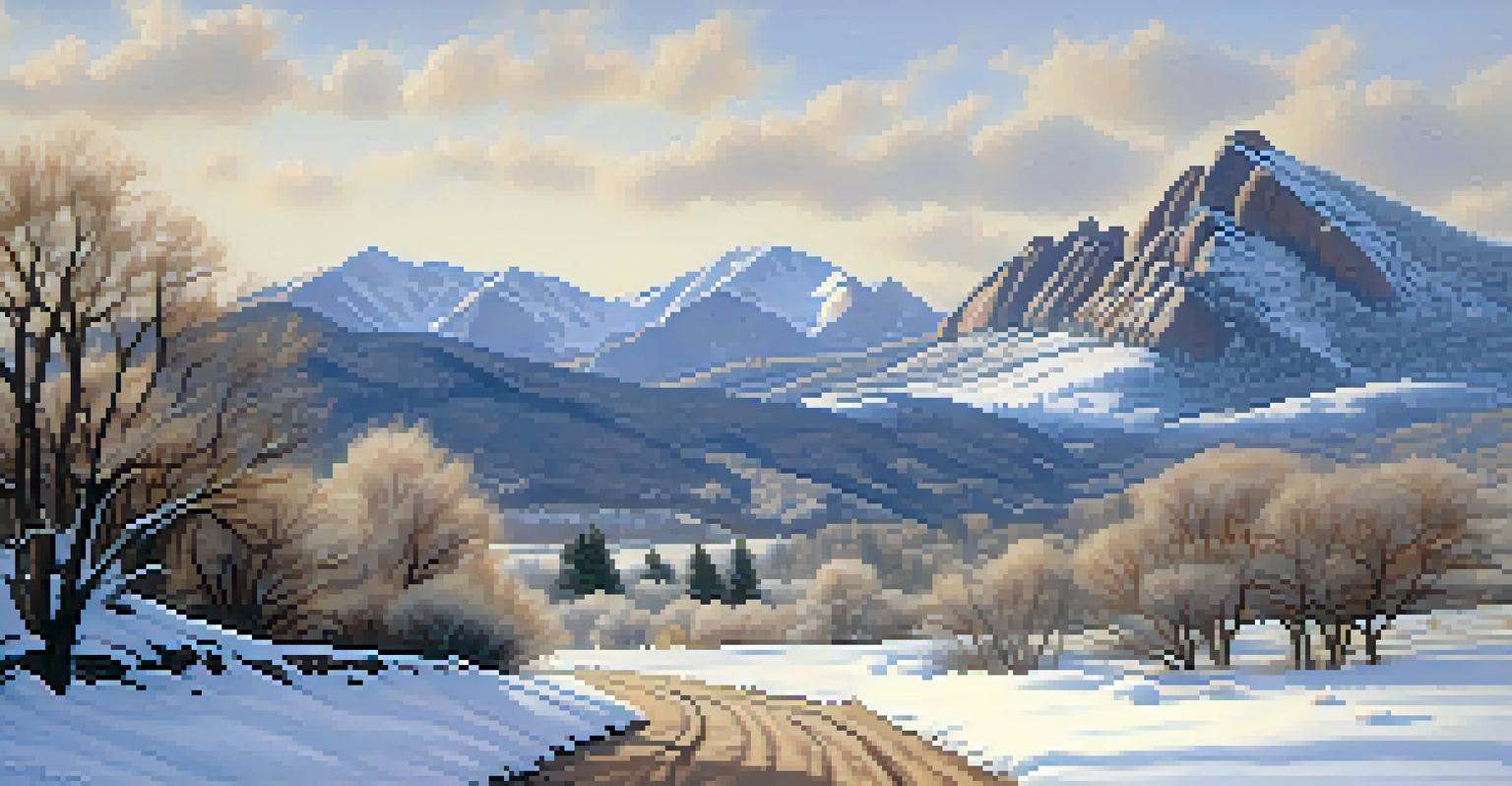The Impact of Boulder's Topography on Local Wildlife Habitats

Understanding Boulder's Unique Topography
Boulder's topography is a stunning mix of flat plains, rolling hills, and steep mountains. This diverse landscape creates a range of microhabitats that support various species. The elevation changes, often dramatic, play a crucial role in determining the types of plants and animals that thrive in each area.
In every walk with nature one receives far more than he seeks.
For instance, the foothills of the Rocky Mountains offer a different ecosystem than the grassy plains. These variations not only provide shelter but also influence food availability, which is vital for wildlife survival. As we delve deeper into how these landscapes interact, we begin to see the intricate relationships between geography and biodiversity.
Understanding this interplay is essential for conservation efforts. By recognizing the unique features of Boulder's topography, we can better appreciate the habitats that support our local wildlife.
How Elevation Affects Biodiversity in Boulder
Boulder’s elevation ranges from about 5,400 feet to over 8,000 feet, creating distinct environmental conditions. As you ascend, temperatures drop and precipitation patterns change, leading to different vegetation zones. These varying climates are like nature's layers, each supporting unique forms of life.

For example, lower elevations are often dominated by scrub, while alpine zones at higher elevations host hardy species adapted to harsher conditions. This elevation gradient not only influences which animals can thrive but also shapes their behaviors and migration patterns. The result is a rich tapestry of life that reflects the challenges and advantages of each habitat.
Boulder's Topography and Biodiversity
The diverse landscape of Boulder, from flat plains to steep mountains, creates unique microhabitats that support a variety of plant and animal species.
As we study these patterns, we can gain insights into how climate change may impact these delicate ecosystems. Understanding how elevation affects biodiversity allows us to develop more effective conservation strategies.
The Role of Water Sources in Wildlife Habitats
Water sources in Boulder, from rivers to small streams, are vital for local wildlife. These areas not only provide drinking water but also serve as corridors for species movement. Animals often rely on these waterways for sustenance, making them crucial hotspots for biodiversity.
What we are doing to the forests of the world is but a mirror reflection of what we are doing to ourselves and to one another.
Consider the South Boulder Creek, which attracts various species, including birds, mammals, and insects. The presence of water fosters lush vegetation, creating a habitat that supports a much wider range of wildlife. This interaction between water and land showcases the importance of these resources in maintaining ecological balance.
Protecting our water sources is therefore paramount. By ensuring clean and accessible waterways, we support the diverse life forms that depend on them.
Rock Formations: Natural Shelters for Wildlife
Boulder's rocky terrain provides natural shelters for numerous wildlife species. These formations serve as hideouts from predators and harsh weather, creating safe havens for animals. From the iconic Flatirons to smaller outcrops, these structures play a pivotal role in local ecosystems.
Animals such as foxes and coyotes often use these rocky areas to den and raise their young. Birds, too, find refuge in crevices, using them for nesting and protection. This natural architecture not only aids in survival but also adds complexity to the habitat by creating microclimates within the larger ecosystem.
Water Sources are Crucial for Wildlife
Boulder's rivers and streams provide essential drinking water and habitats, acting as corridors for movement and sustaining local biodiversity.
Understanding the importance of these rock formations helps us appreciate the need for their preservation. As we safeguard these unique structures, we also protect the wildlife that relies on them.
Seasonal Changes and Their Impact on Local Wildlife
Boulder's wildlife is deeply influenced by the changing seasons, each bringing distinct challenges and opportunities. For instance, the arrival of winter can drastically alter food availability and shelter options. Animals often adapt by changing their diets or seeking warmer habitats.
During spring and summer, the vibrant bloom of wildflowers and the abundance of insects support a flourishing community of pollinators and herbivores. This seasonal rhythm not only affects individual species but also the entire ecosystem's dynamics. The interconnectedness of these seasonal changes highlights the delicate balance of life in Boulder.
By observing these seasonal shifts, we can better understand wildlife behavior and anticipate potential conservation needs. This knowledge is vital for ensuring the survival of various species throughout the year.
Human Impact on Boulder's Wildlife Habitats
As Boulder's population grows, human activities increasingly affect local wildlife habitats. Urban development, pollution, and recreational activities can disrupt the delicate ecosystems that have evolved over centuries. It's a reminder that our actions have far-reaching consequences on the natural world.
For example, trails and roads can fragment habitats, making it difficult for animals to move freely. This can lead to decreased genetic diversity and increased competition for resources. Understanding these impacts is crucial as we strive to balance human needs with wildlife conservation.
Human Activities Impact Wildlife
As urban development increases, human actions disrupt Boulder's delicate ecosystems, highlighting the need for community engagement in conservation efforts.
Engaging the community in conservation efforts is essential. By raising awareness about our impact, we can work together to create solutions that protect Boulder's unique wildlife.
Conservation Efforts to Protect Wildlife Habitats
Various organizations in Boulder are committed to preserving local wildlife habitats. Through habitat restoration, education, and community outreach, these groups work tirelessly to maintain the ecological integrity of the region. Their efforts are vital in combating the threats posed by urbanization and climate change.
For instance, initiatives to restore native vegetation can provide essential resources for wildlife, enhancing food availability and shelter. Additionally, educational programs inform residents about the importance of biodiversity and how they can contribute to conservation efforts. Community involvement is key to fostering a culture of stewardship.

By supporting these conservation initiatives, we can collectively ensure that Boulder's rich wildlife habitats endure for future generations. It’s a community effort that underscores the importance of protecting our natural heritage.